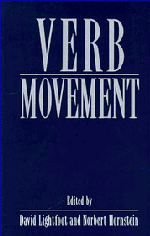Book contents
- Frontmatter
- Contents
- List of contributors
- Preface
- Verb movement: an introduction
- 1 Verb positions: evidence from Italian
- 2 Verb movement and word order in Arabic
- 3 Comments on the paper by Ouhalla
- 4 Some similarities and differences between Icelandic and Yiddish
- 5 Comments on the paper by Santorini
- 6 Finite verb movement in Scandinavian embedded clauses
- 7 Comments on the paper by Vikner
- 8 The Brythonic copula and head raising
- 9 A reinterpretation of evidence for verb movement in French
- 10 Two types of head movement in Romance
- 11 Comments on the paper by Roberts
- 12 Licensing heads
- 13 Comments on the paper by Koopman
- 14 Finiteness and head movement in early child grammars
- 15 Comments on the paper by Wexler
- References
- Index
9 - A reinterpretation of evidence for verb movement in French
Published online by Cambridge University Press: 03 May 2011
- Frontmatter
- Contents
- List of contributors
- Preface
- Verb movement: an introduction
- 1 Verb positions: evidence from Italian
- 2 Verb movement and word order in Arabic
- 3 Comments on the paper by Ouhalla
- 4 Some similarities and differences between Icelandic and Yiddish
- 5 Comments on the paper by Santorini
- 6 Finite verb movement in Scandinavian embedded clauses
- 7 Comments on the paper by Vikner
- 8 The Brythonic copula and head raising
- 9 A reinterpretation of evidence for verb movement in French
- 10 Two types of head movement in Romance
- 11 Comments on the paper by Roberts
- 12 Licensing heads
- 13 Comments on the paper by Koopman
- 14 Finiteness and head movement in early child grammars
- 15 Comments on the paper by Wexler
- References
- Index
Summary
Introduction
In this paper, I will examine a very influential analysis of the structure of the English and French auxiliary systems, an analysis which posits verb raising or movement as a central device. The authors' assumptions about very basic aspects of linguistic structure lead inevitably to this description. I, in fact, am more interested in these assumptions than in whether or not verb movement is a device in the repertoire of syntactic description, as it surely is, for these assumptions are widely shared and reasonable ones, but I think incorrect.
The analysis is Emonds' (1978) and Pollock's (1989). The reasonable assumption lying behind the analysis is that adverbs, and other modifiers, such as negation, occupy fixed positions, so that any observed alternation of their positioning with respect to verbs must therefore be due to verb movement. What is of most interest in this context is to determine more precisely what the rules of distribution and interpretation for these elements are. I will reject the idea that there are universal “slots” in which adverbs of various kinds can appear, one slot for each type of adverb; nor do I think that adverbs are distributed in the same way in different languages. The modes of modification are more various than that. On the other hand, I do think there is a simple elegant set of notions of scope and modification which gets the adverbs right, interacting in the popular way with language-wide parameter settings.
- Type
- Chapter
- Information
- Verb Movement , pp. 189 - 206Publisher: Cambridge University PressPrint publication year: 1994
- 6
- Cited by

